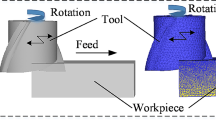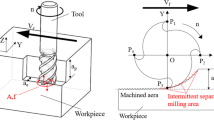Abstract
Axial ultrasonic vibration-assisted micro-milling (UVAM) has emerged as an advanced technique that can be tailored to improve the machinability of difficult-to-machine materials such as 316L stainless steel. This article sets out to meticulously compare and analyze the cutting performance of conventional milling (CM) and UVAM techniques in the side milling of 316L stainless steel. The cutting separation characteristics of UVAM of 316L stainless steel are elucidated, and the air-cutting ratio in UVAM is introduced. The relationship between the air cutting ratio and spindle speed is also derived. Based on theory, the finite element simulation and experiments are compared under both milling conditions. An analysis of the results for these two sections is presented to validate the theoretical derivation. The results show that the trend and analysis of the experimental cutting forces are aligned with those in the simulation. The cutting forces also confirm the reliability of the simulation results. Due to factors such as tool wear, there is a deviation of 5–20% between the experimental values and the simulation results. A chip variation analysis in the simulation also corresponds to the trend in cutting temperature. An evaluation of the surface morphology and roughness of the experimental samples reveals that the surface quality and smoothness under UVAM are superior to those under CM. Tool wear analysis indicates that the carbide tool undergoes severe wear in the side milling of 316L stainless steel. In summary, the simulation and experiments convincingly demonstrate the advantages of UVAM technology and provide a reference for optimizing the milling process of challenging materials.


















Similar content being viewed by others
Data availability
All data generated or analyzed during this study are included in this published article, and further request can be contacted with the corresponding author.
Abbreviations
- CM:
-
Conventional milling
- UVAM:
-
Axial ultrasonic vibration-assisted micro-milling
- Z :
-
Number of tool teeth
- I :
-
i Th tooth of the tool
- R :
-
Tool radius
- D :
-
Tool diameter
- f z :
-
Feed per tooth
- f u :
-
Feed rate
- θ :
-
Angle that the tool has rotated
- A :
-
Ultrasonic vibration amplitude
- F :
-
Ultrasonic vibration frequency
- n :
-
Spindle speed
- a e :
-
Milling width
- t :
-
Milling time
- x i, y i, z i :
-
Cutting edge kinematic trajectory
- k, k ' :
-
Slope
- β :
-
Tool helix angle
- β' :
-
Nominal helix angle
- θ fl :
-
Dynamic rotation angle of the cutting edge
- θ l :
-
Spindle rotation angle
- ω fl :
-
Angular velocity of the cutting edge
- ω l :
-
Angular velocity of the spindle
- θ e :
-
Air cutting angle
- θ c :
-
Cutting angle
- δ :
-
Air cutting ratio
- ρ :
-
Density
- E :
-
Young’s modulus
- ν :
-
Poisson ratio
- γ :
-
Coefficient of thermal expansion
- λ :
-
Thermal conductivity
- C :
-
Specific heat capacity
- A ', B, C ', n', m :
-
Johnson-Cook material constants
- \(\varepsilon\) :
-
Equivalent plastic strain
- \(\dot{\varepsilon }\) :
-
Equivalent plastic strain rate
- \(\dot{{\varepsilon }_{0}}\) :
-
Reference strain
- T melt :
-
Melting temperature
- T room :
-
Room temperature
- G :
-
Shear modulus
- b :
-
Burgers vector
- α :
-
Cutting front angle
- μ :
-
Correction factor
- L :
-
Length of the primary shear deformation zone
- t min :
-
Minimum cutting thickness
- t c :
-
Cutting layer thickness
- t 0 :
-
Cutting thickness of chip formation
- r e :
-
Cutting edge radius
- γ 0 :
-
Tool rake angle
- φ :
-
Shear angle
- w :
-
Failure state scalar
- \({\overline{\varepsilon }}_{0}^{pl}\) :
-
Initial equivalent plastic strain
- \(\Delta {\overline{\varepsilon }}^{pl}\) :
-
Equivalent plastic strain increment
- \({\overline{\varepsilon }}_{D}^{pl}\) :
-
Critical equivalent plastic strain
- d 1, d 2, d 3, d 4, d 5 :
-
Failure parameters
- p :
-
Material hydrostatic pressure
- q :
-
Equivalent stress
- \({\dot{\overline{\varepsilon }}}^{pl}\) :
-
Equivalent plastic strain rate
- G f :
-
Fracture energy
- K l :
-
Fracture toughness of the material
- E ' :
-
Elastic modulus
References
Chen N, Li HN, Wu JM, Li ZJ, Li L, Liu GY, He N (2021) Advances in micro milling: from tool fabrication to process outcomes. Int J Mach Tool Manu 160:103670. https://doi.org/10.1016/j.ijmachtools.2020.103670
Gao P, Liang ZQ, Wang XB, Zhou TF, Li SD, Zhang SY, Li-u ZB (2017) Cutting edge damage in grinding of cemented carbides micro end mills. Ceram Int 43:11331–11338. https://doi.org/10.1016/j.ceramint.2017.05.336
O’Toole L, Kang CW, Fang FZ (2021) Precision micro-milling process: state of the art. Adv Manuf 9:173–205. https://doi.org/10.1007/s40436-020-00323-0
Verma GC, Pandey PM (2019) Machining forces in ultrasonic-vibration assisted end milling. Ultrasonics 94:350–363. https://doi.org/10.1016/j.ultras.2018.07.004
Cao Y, Zhu YJ, Ding WF, Qiu YT, Wang LF, Xu JH (2022) Vibration coupling effects and machining behavior of ultrasonic vibration plate device for creep-feed grinding of Incone-l 718 nickel-based superalloy. Chin J Aeronaut 35:332–345. https://doi.org/10.1016/j.cja.2020.12.039
Hamada A, Khosravifard A, Ali M, Ghosh S, Jaskari M, Hie-tala M, Järvenpää A, Newishy M (2023) Micromechanical analysis and finite element modelling of laser-welded 5-mm-thick dissimilar joints between 316L stainless steel and low-alloyed ultra-high-strength steel. Mater Sci Eng: A 882:145442. https://doi.org/10.1016/j.msea.2023.145442
Tasalloti H, Kah P, Martikainen J (2017) Effect of heat inputon dissimilar welds of ultra high strength steel and duplex stainless steel: Microstructural and compositional analysis. Mater Charact 123:29–41. https://doi.org/10.1016/j.matchar.2016.11.014
San-Juan M, Martín Ó, De-Tiedra P, Santos FJ, López R, Ce-brián JA (2015) Study of cutting forces and temperatures in milling of AISI 316L. Procedia Eng 132:500–506. https://doi.org/10.1016/j.proeng.2015.12.525
Al-Mamun NS, Deen KM, Haider W, Asselin E, Shabib I (2020) Corrosion behavior and biocompatibility of additively manufactured 316L stainless steel in a physiological environment: the effect of citrate ions. Addit Manuf 34:101237. https://doi.org/10.1016/j.addma.2020.101237
Karthikeyan S, Mohan B, Kathiresan S (2021) Influence of rotational magnetorheological abrasive flow finishing process on biocompatibility of stainless steel 316L. J of Materi E-ng and Perform 30:1545–1553. https://doi.org/10.1007/s11665-020-05442-0
Salem A, Guezmil M, Bensalah W, Mezlini S (2022) Tribocorrosion behavior of 316L and HDPE composites for orthopedic application. Mater Today Commun 31:103582. https://doi.org/10.1016/j.mtcomm.2022.103582
Maranhão C, Davim JP (2010) Finite element modelling of machining of AISI 316 steel: Numerical simulation and experimental validation. Simul Model Pract Theory 18:139–156. https://doi.org/10.1016/j.simpat.2009.10.001
Liu SP, Tu YQ (2021) Dry and wet milling of 316L stainlesssteel at high feed rate. Tool Technol 51:113–114. https://doi.org/10.16567/j.cnki.1000-7008.2017.11.029
Li JH, Liu GH, **ong XW (2022) Effect of milling parameter on cutting performance of 316L stainless steel. Tool Technol 56:94–96. https://doi.org/10.3969/j.issn.1000-7008.2022.05.021
Lv DJ, Wang YG, Yu X (2020) Effects of cutting edge radius on cutting force, tool wear, and life in milling of SUS-316L steel. Int J Adv Manuf Technol 111:2833–2844. https://doi.org/10.1007/s00170-020-06286-7
Hajiahmadi S (2019) Burr size investigation in micro milling of stainless steel 316L. Int J Lightweight Mater Manufacture 2:296–304. https://doi.org/10.1016/j.ijlmm.2019.07.004
Zhu J, Yin Z, Zhang K, Zhang P (2022) Experimental study of axial ultrasonic vibration turning 316L stainless steel. Machine Tool Hydraulics 50:1–8. https://doi.org/10.3969/j.issn.1001-3881.2022.24.001
Li BQ, Li Y, Ma YH (2019) Milling simulation and experimental research of 316L stainless steel. Sci Technol Vision 31:71–72. https://doi.org/10.19694/j.cnki.issn2095-2457.2019.31.032
Sui H, Zhang LF, Wang S, Gu ZJ (2021) Theoretical and experimental investigation into the machining performance in axial ultrasonic vibration-assisted cutting of Ti6Al4V. Int J A-dv Manuf Technol 116:449–472. https://doi.org/10.1007/s00170-021-07447-y
Verma GC, Pandey PM, Dixit US (2018) Modeling of static machining force in axial ultrasonic-vibration assisted milling considering acoustic softening. Int J Mech Sci 136:1–16. https://doi.org/10.1016/j.ijmecsci.2017.11.048
Liu XF, Wang WH, Jiang RS, **ong YF, Lin KY (2020) Tool wear mechanisms in axial ultrasonic vibration assisted milling in-situ TiB2/7050Al metal matrix composites. Adv Ma-nuf 8:252–264. https://doi.org/10.1007/s40436-020-00294-2
Sui H, Zhang LF, Wang S, Gu ZJ (2020) Transient separation cutting characteristic of axial ultrasonic vibration–assisted cutting. Int J Adv Manuf Technol 110:2407–2425. https://doi.org/10.1007/s00170-020-06020-3
An YW, Bai HQ, Bao J, Qin W, Ren L (2021) Analysis on milling surface quality of 316L stainless steel laser cladding forming parts. Machine Tool Hydraulics 49:61–66. https://doi.org/10.3969/j.issn.1001-3881.2021.22.012
Gong YD, Li PF (2019) Analysis of tool wear performance and surface quality in post milling of additive manufactured 316L stainless steel. J Mech Sci Technol 33:2387–2395. https://doi.org/10.1007/s12206-019-0237-x
Greco S, Klauer K, Kirsch B, Aurich JC (2021) Vibration-assisted micro milling of AISI 316L produced by laser-based powder bedfusion. J Manuf Process 71:298–305. https://doi.org/10.1016/j.jmapro.2021.09.020
Umbrello D, M' Saoubi R, Outeiro JC (2007) The influence of Johnson-Cook material constants on finite element simulation of machining of AISI 316L steel. Int J Mach Tool Man-u 47:462–470. https://doi.org/10.1016/j.ijmachtools.2006.06.006
Tounsi N, Vincenti J, Otho A, Elbestawi MA (2002) From the basics of orthogonal metal cutting toward the identification of the constitutive equation. Int J Mach Tool Manu 42:1373–1383. https://doi.org/10.1016/S0890-6955(02)00046-9
Zhao S (2020) Simulation and experimental research on micro drilling of difficult-to-machine materials. North China University of Science and Technology. https://doi.org/10.27108/d.cnki.ghelu.2020.000116
Kim C-J (2004) Mechanisms of chip formation and cutting dynamics in the micro-scale milling process. Dissertation, University of Michigan, USA. https://api.semanticscholar.org/CorpusID:136117209
Luo Y, Zheng KY, Zhao PH, Zhang Y (2023) Machining characteristics of 316L stainless steel in hybrid manufacturing via a three-dimensional thermal-mechanical coupled model. J Manuf Process 102:275–296. https://doi.org/10.1016/j.jmapro.2023.06.021
Li Y, Zhang ML, Dong HT, Chen JX, Liu XF (2021) Simulation analysis of elliptical vibration turning 316L stainless steel. Modular Machine Tool & Automatic Manufac Technique 4:163–168. https://doi.org/10.13462/j.cnki.mmtamt.2021.04.039
Dandekar CR, Shin YC (2009) Multi-step 3-D finite element modeling of subsurface damage in machining particulate reinforced metal Matrix composites. Composites 40:1231–1239. https://doi.org/10.1016/j.compositesa.2009.05.017
Funding
This work was supported by the Key Research and Development Plan in Shanxi Province of China (201803D421045).
Author information
Authors and Affiliations
Contributions
Xu Feng: methodology, investigation, data curation, formal analysis, writing—original draft, writing—review and editing. Zhiguo Dong: methodology, supervision, writing—review and editing. Bo Li: investigation, experimental support. Hui Peng: investigation, experimental support.
Corresponding author
Ethics declarations
Ethics approval
Not applicable.
Consent to participate
Not applicable.
Consent to publish
Not applicable.
Competing interest
The authors declare no competing interests.
Additional information
Publisher's Note
Springer Nature remains neutral with regard to jurisdictional claims in published maps and institutional affiliations.
Rights and permissions
Springer Nature or its licensor (e.g. a society or other partner) holds exclusive rights to this article under a publishing agreement with the author(s) or other rightsholder(s); author self-archiving of the accepted manuscript version of this article is solely governed by the terms of such publishing agreement and applicable law.
About this article
Cite this article
Feng, X., Dong, Z., Li, B. et al. Finite element simulation and experimental analysis of axial ultrasonic vibration-assisted micro-milling of 316L stainless steel. Int J Adv Manuf Technol (2024). https://doi.org/10.1007/s00170-024-13807-1
Received:
Accepted:
Published:
DOI: https://doi.org/10.1007/s00170-024-13807-1




